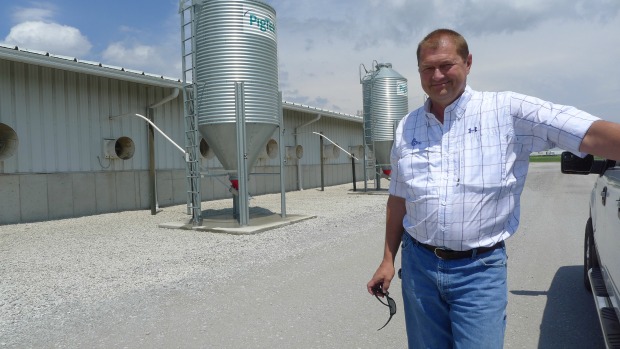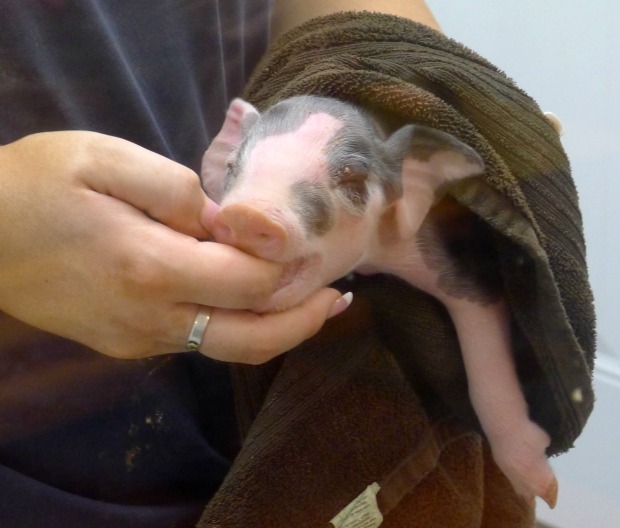After pig farm raises a stink, Hoosiers debate rural-city divide
By Michael Puente

After pig farm raises a stink, Hoosiers debate rural-city divide
By Michael PuenteRobin Bartholomew has lived all of her life in and around Valparaiso, Ind., about an hour east of Chicago. Much of that time has been around farms.
“As I was growing up, there were some hog farms and cattle, just the typical family farm grazing, open air,” Bartholomew said.
But when a local family recently proposed a farm to house up to 6,000 pig farm, Bartholomew was outraged. The proposed facility would’ve sat a few hundred yards from homes and about a mile from Valparaiso’s bustling downtown shopping district.
“It’s a factory for pigs,” she said. “The sewage would have been spread during the spring and fall when the wind is frequently out of the south, which would have blown directly into Valparaiso. There would have been no avoiding the impact this place would have had on this whole area.”
Bartholomew worried about not just the smell, but the potential impact to groundwater.
The farmers, Robert and Tammy Sands, wanted a zoning change to run a concentrated animal feeding operation, or CAFO for short. There are around 1,800 of these large-scale livestock operations in Indiana, according to the Indiana Department of Environmental Management.
Some house chickens, cows and, of course, pigs.

“Because we are in a state that has a lot of wide open spaces, without a lot of people in certain areas, this is just a great state to raise livestock,” said Malcolm De Kryger, a longtime pig farmer. “Our state government has shown that it has been a great economic developer for rural areas.”
De Kryger is president of Belstra Milling Company of DeMotte, Ind. The company breeds up to 400,000 baby pigs annually at his six operations located in both Indiana and Illinois. About 90 minutes south of Chicago De Kryger also operates the Pig Adventure at Fair Oaks Farm, which doubles as a learning center and tourist attraction for the public.

At Pig Adventure, which is a full-fledged CAFO, there are rows and rows of pigs in a giant warehouse and a nursery where hundreds of piglets are born every day.
“They poop, they play and they sleep. That’s their life,” De Kryger said on a recent day outside the pig farm CAFO, which houses about 2,500 pigs.
About one-third of De Kryger’s piglets wind up at other farms to continue growing and well, eventually become bacon. Many of them were set to be transported to the controversial hog farm outside Valpo.
But now, that’s not going to happen.
After a month of vocal opposition, much of it on social media, the Sands family said last week that they were dropping the idea altogether.
Many Valpo residents cheered the news. But the decision raises the question of how livestock farms can exist alongside growing Hoosier cities.
“The vitriol that was thrown at them because they were trying to figure out how to enhance their family operation was pretty sad,” De Kryger said.
De Kryger sympathizes with the Sands family because it’s harder nowadays to make a living on a small farm. He says the Sands Family wanted to be part of Indiana’s growing 3-billion dollar pork industry.
De Kryger disputed claims that the proposed facility would have lowered property values or damaged the environment. And he says odors at concentrated animal feeding operations are barely noticeable — although the manure is often used as fertilizer for adjacent crops.
“(CAFOs) are not trouble-makers by and large,” he said. “For people to just say ‘I might see you, I might smell you, I’m afraid of you, I don’t want you,’ I found that to be very disappointing.”
“They are big and recognizable,” said Greg Slipher with the Indiana Farm Bureau. “They are buildings that are not my grandfather’s farm so they do draw attention to themselves.”
Slipher says activists opposing a farm expansion is nothing new in Indiana, but the strong public outcry that happened in Valparaiso was unusual. Especially since the Sands family had long ties to the community.
“The management, the investment, the environmental responsibility, the community responsibility, all of that falls on the family — yes, the family farm,” he said. “We often say the business has changed, the people haven’t. We still are overwhelmingly family farms in Indiana.”
The Sands Family declined to comment for this story, but last week released a statement.
“When news about our proposal became public, we were surprised by the response and the amount of public outcry it caused,” the Sands stated. “We were disappointed in the way activist groups from outside our community took advantage of a constructive county-level dialogue in an effort to promote anti-agriculture agendas, particularly attacking a family farm that has been a part of this community for 20 years. Activist misinformation, untruths and fear mongering have no place in what should remain a local decision.”
But other groups like the Hoosier Environmental Council, applauded the decision by the Sands.
“This is great news for the hundreds of families who would have been living dangerously close to the hog factory — families who rely on groundwater wells for drinking water and for everyone who enjoys Valparaiso’s newly revitalized downtown area — an area that would have been down wind of 7,000 hogs and their waste,” the HEC said in a statement.
But not all who opposed the pig farm were activists. Some were powerful politicians.
“It’s kind of hard to imagine there being a general anti-agriculture [sentiment] because the farmers feed us. We all are grateful for our farmers,” said Valparaiso Mayor Jon Costas, a Republican. “It’s just raising livestock is an intense use that emits an odor and that was really the concern.’
Costas says he’d support another location if it were further away.
“They are very nice people and this was quite an experience for them. In this case, I don’t think they were prepared for the type of outcry. Plus, with the advent of social media, news travels fast and bad news travels fast too,” Costas said. “I think if they went three or four miles south, that would be fine.”
But for residents like Robin Bartholomew, these kind of intense-use livestock farms will never be welcome anywhere in Porter County.
“High-impact opens the door for landfills, hazardous waste sites. We don’t want that in Porter County. We’ll be more vigilant from now on,” Bartholomew said. “We’ll be on the look out at all times to make sure nothing like this ever happens again.”
Except, it’s already happened.
There are 4,000 pigs at a large CAFO just 10 miles south of Valpo that’s been in operation for years — without raising much of a stink.
Michael Puente is WBEZ’s Northwest Indiana Bureau Reporter. Following him @MikePuenteNews.